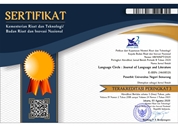SAFETALK PRACTICES IN CONTENT AND LANGUAGE INTEGRATED LEARNING (CLIL) CLASSES
(1) English Department Universitas Negeri Semarang Indonesia
Abstract
This article is drawn from a larger ethnographic case study of a state senior high school in a city in the province of Central Java, Indonesia. The study was classroom discourse analysis, focusing on identifying and examining classroom interactional and pedagogical practices in Content and Language Integrated Learning (CLIL) lessons. CLIL is a type of bilingual education in which some content areas (such as Sciences) are learned through a foreign language. The research participants in this study were Indonesian teachers of Mathematics, Biology, and Geography who were encouraged to teach their subjects in English language because of the political ideology and educational policy at the time the data collected. The data emerged from classroom observations notes, lesson transcripts, and post-lesson interviews with video-stimulated recall. The interpretation and analysis of the data involved cross-checking different sources of evidence. Braun and Clarke’s thematic analysis (2006) was employed in the analysis of the data. The finding reveals that there was a salient pattern in the interactional and pedagogical practices of the subject teachers which can be called safetalk. The finding also shows that safetalk hinder the students’ second language acquisition and development. This article offers deeper insights on the interaction and pedagogy in CLIL classes, which can promote critical reflection and contribute to future English bilingual teacher education, particularly in the Indonesian educational contexts.
Keywords
Full Text:
PDFReferences
Baker, C. 1993. Bilingual Education in Wales. In H. Baetens Beardsmore (ed.),European Models of Bilingual Education (pp. 7-29). Clevedon: Multilingual Matters.
Baker, C. 2011. Foundations of Bilingual Education and Bilingualism (5thed.). Bristol, UK: Multilingual Matters.
Braun, V.& Clarke, V. 2006.Using Thematic Analysis in Psychology.Qualitative Research in Psychology, 3:2, 77-101.
Chick, J. K. 1996. Safe-talk: Collusion in Apartheid Education. In H. Coleman (Ed.), Society and the Language Classroom (pp. 21-39). Cambridge: Cambridge University Press.
Chimbutane, F. S. 2009. The Purpose and Value of Bilingual Education: A Critical, Linguistic Ethnographic Study of Two Rural Primary Schools in Mozambique. (Unpublished doctoral dissertation).The University of Birmingham,United Kingdom.
Chimbutane, F. 2011. Rethinking Bilingual Education in PostcolonialContexts.Bristol: Multilingual Matters.
Creswell, J. W. 2013. Qualitative Inquiry and Research Design: Choosing among Five Approaches (3rd. ed.). Thousand Oaks: SagePublications
Dalton-Puffer, C. 2007.Discourse in CLIL classrooms. Amsterdam:Benjamins.
Ellis, R. 2008. The Study of Second Language Acquisition (2nded.). Oxford: Oxford University Press.
Fitriati, S.W. 2015. Teachers’ Language Ideologies and Classroom Practices in English Bilingual Education: An Ethnographic Case Study of a Senior High School in Central Java, Indonesia. (Unpublished doctoral dissertation).The University of Southern Queensland, Australia.
Garcia, O. 2009.Bilingual Education in the 21st Century: A GlobalPerspective. United Kingdom: Wiley-Blackwell.
Graaff, R. D., Koopman, G. J., &Westhoff, G. 2007. Identifying Effective L2Pedagogy in Content and Language Integrated Learning (CLIL).ViewsVienna English Working Papers, 16(3), 12-19.
Hornberger, N. H., & Chick, J. K. 2001. Co-constructing School Safetime: Safetalk practices in Peruvian and South African classrooms. In M. Heller & M. Martin-Jones (Eds.), Voices of Authority: Education andLinguistic Difference (pp. 31-56). London: Ablex.
Krashen, S. 1985. The Input Hypothesis. Beverly Hills, CA: Laredo Publishing Company.
Krashen, S. 1994. Bilingual Education and Second Language Acquisition Theory. In B. E. Office (Ed.), Schooling and Language MinorityStudents: A Theoretical Framework (2 ed., pp. 47-75). Los Angeles, CA: California State University, National Evaluation, Dissemination andAssessment Center.
Martin, P. 2005. 'Safe' Language Practices in Two Rural Schools in Malaysia: Tensions between Policy and Practice. In A. M. Y. Lin & P. Martin (Eds.), Decolonisation, Globalisation: Language-in-Education Policyand Practice (pp. 74-97). Clevedon: Multilingual Matters.
Mills, K. A. 2007. Access to Multiliteracies: A Critical Ethnography.Ethnography and Education, 2(3), 305-325.
Palmer, D. 2011. The Discourse of Transition: Teachers' Language Ideologies WithinTransitional Bilingual Education Programs. International Multilingual Research Journal, 5(2), 103-122.
Snow, M. A. 2001. Content-Based and Immersion Models for Second andForeign Language Teaching. In M. Celce-Murcia (Ed.), Teaching Englishas a Second or Foreign Language (3 ed., pp. 303-318). USA: Heinle&Heinle.
Swain, M., & Johnson, R. K. 1997. Immersion Education: A Category within Bilingual Education. In R. K. S. Johnson, M. (Ed.), ImmersionEducation: International Perspective. UK: Cambridge University Press.
Refbacks
- There are currently no refbacks.

This work is licensed under a Creative Commons Attribution 4.0 International License

